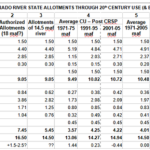
I hope you’ll excuse my irreverence in showing the image above. If you haven’t noticed, ‘what’s real’ versus what we wish were real is what a lot of our discourse is about these days, and not just along the Colorado River. Denial is more than just a river in Egypt.
But moving on – I concluded the last post with a discussion of the first real break the First Peoples of the arid lands got after being forced onto reservations that were far too small for their timeless lives as hunter-foragers (requiring as much as a square mile or two per person in the arid lands). The U.S. Supreme Court decreed in 1908, in Winters v. The United States, that when the federal government reserved western land for any purpose (removed it from private-sector development), it also implicitly reserved enough water to carry out the purpose of the reservation.
For the First Peoples put on dryland reservations, the ‘Winters doctrine’ meant enough water had to be reserved to ‘civilize’ the First Peoples, primarily via irrigated farming. Quite a lot of water, in other words – enough reserved, with seniority to the date of the reservation’s creation, to throw a little panic in the hearts of the conquering Second People who, by the turn of the century, were already realizing the water supply was not really infinite.
But the Court said nothing in Winters about how the First Peoples – then still struggling just to maintain their cultural identities under a heavy-handed federal policy of forced assimilation – might go about obtaining their entitlement of water. And more to the point, with no developed economy of their own: how to turn that ‘Winters water’ into real water flowing onto the land and into their communities.
Given the supposedly benevolent and paternalistic trust relationship established in their treaties with the federal government, the First Peoples were aware that the ‘Great Father’ held their implied water rights in trust for them, just as the feds held the reservation in trust for them. So it seemed reasonable to presume that the government would be bound by the trust’s fiduciary responsibilities to help them do such basic things as determining how much water the Winters doctrine gave them, and helping them plan for the development of the water.
But while the Winters decision itself was not openly contested, the Bureau of Indian Affairs, the Bureau of Reclamation and other Interior Department agencies did not jump eagerly into implementing it; they instead argued that there was nothing explicit in the treaties requiring them as federal trustees to help in assessing and developing the implicit Winters rights. This position was quite explicitly – as it were – affirmed just this past June, in the decision on a suit that the Navajo Nation began more than a decade ago against the Department of Interior, but which ended up before the Supreme Court as Arizona v. The Navajo Nation. The Supremes essentially absolved the federal agencies of any obligation not explicitly stated in the original reservation treaties – even though most of the treaties never got really specific about the trustee’s fiduciary obligations to the tribes. Had the current Supreme Court majority been deciding the Winters case in 1908, one suspects the whole issue of First People reserved water rights would never have made it out of the courtroom; the Fort Belknap Reservation treaty considered in the Winters decision said nothing explicitly about water rights reserved for the reservation.
The Supremes’ 5-4 decision against the Navajo plea this summer did not, however, go so far as some of the reporting in major media suggested. It did not, for example, really ‘dash the hopes of the Navajo Nation for more running water,’ as was reported in the L.A. Times, suggesting the federal government would henceforth deny water to the reservation.
In fact, while the Court was considering the case, the U.S. Bureau of Reclamation was plugging away on a multi-billion dollar 300-mile set of pipelines and pumps from the San Juan River in northern New Mexico as far south and west as Gallup, and eventually into Arizona and the Navajo capital in Window Rock, Arizona, bringing reliable and sustainable domestic water to numerous Navajo communities en route. In exchange for that project, the Navajo People will give up some of their still unquantified water rights – just as they did back in the 1960s when the Bureau undertook the Navajo Indian Irrigation Project, to irrigate 110,000 acres of reservation land. (There will be more about the NIIP somewhere down the line: an interesting story in itself.)
These water projects for the Navajo move slowly – some of the planned NIIP irrigation system is still not completed sixty years later, and the anticipated completion of the pipeline project has been pushed back from 2024 to 2029. But the feds have in fact exercised some of their presumed fiduciary responsibility to help bring running water to the Navajo – even though the Supremes just said they have no explicit legal obligation to do so.
But the feds are still reluctant to provide what the Navajo most want – and have been requesting for decades: knowledge of how much water they actually have ‘reserved,’ in order to do their own water planning for whatever is left. The longest, most articulate and most interesting part of the Arizona v. Navajo Nation decision is Justice Gorsuch’s dissent against the conservative majority he usually joins. In addition to a thorough history of the relationship between the United States and the Navajo Nation from the beginning, he explores the big gray zone between the explicit letter of the law and the often more implicit spirit of the law. He all but accuses his conservative colleagues of fussy pettiness in their insistence on explicit water-development instructions for the government in treaties that often predated formal water law in the West.
The Navajo People are not alone in this ambiguous situation; most of the First Peoples in the Colorado River region who tried to get an answer on how much water is ‘reserved’ for their use, encountered the same ambiguity and reluctance from the federal government that had claimed the water and land in trust for them.
Basically this is not so much residual anti-Indian bias, as it is the First Peoples caught in the middle of a perpetual American tussle over the prerogatives of individual states in the more federated than united states. The ‘first-come-first-served’ appropriation law for water use evolved from the bottom up in all of the arid-land states from the time they were territories, and with a clear bias toward protecting existing users. Water law thus came to be developed and administered at the state level – a prerogative guarded jealously by each state. Only interstate water disputes and problems involving federal lands (like the Winters case) went directly to the federal court system, often straight to the U.S. Supreme Court as the trial court.
Readers can thus imagine the consternation caused by the Supreme Court’s assertion of federal reserved water rights for any reservation of land that required water to fulfill the purpose of the reservation; this meant large quantities of water effectively removed from the state-administered appropriation systems – a huge wild card dropped in their already complicated water games. For organizations like the federal government that tend to kick controversial cans of worms down the road as far as possible, this meant putting off federal-versus-state showdowns like quantifying First People water rights.
This particular situation was, in the way of governments, clarified through adding further complexity in 1952, with an amendment to the section of the United States Code that gives the federal government ‘sovereign immunity’ against being sued for its actions. The ‘McCarran Amendment’ – by Nevada Senator Pat McCarran – waived that federal immunity for situations involving the states’ adjudication and administration of water rights. The federal government, in other words, would have to submit its senior reserved rights to state adjudication and administration; this would give all other water users impacted by the use of the reserved water the opportunity to oppose that use, and even to sue the federal government if their concerns were not addressed.
This established the state courts as the place where the First People water rights would have to be ultimately quantified and adjudicated. There are two ways in which the Peoples go about that. One way was to get their own reasonable estimates of their ‘civilizing’ needs, based on ‘practicably irrigable land,’ domestic and industrial needs to develop a ‘modern life,’ and go to court with that claim. Interior Department agencies will support them without taking the lead, trust notwithstanding. But depending on the quantity desired, it is a slow process, averaging well over a decade and with some tribal claims going on for two or three decades. And the ultimate decree is seldom what was asked. The Hopi People went through the court system, but withdrew their claim when the court offered them only a quarter of their claim.
And when the court process is over, as one tribal leader put it, what you have is ‘paper water,’ and the People are still faced with the challenge of turning the adjudicated amount into water flowing in ditches and pipes.
The other alternative for the tribes is a negotiated settlement: tribal leaders take their estimates of the Winters water rights they could reasonably expect to eventually get from the courts, and sit down in a mediated palaver with other water users, large and small, that are either already using the People’s water (free) or want to be using it in their own future, and they all see what can be worked out so some dependable tribal rights are shoehorned in without serious damage to existing (potentially junior) users. The People can lease or even sell some of their water from federal projects to other parties, in order to get the wherewithal to build systems for putting the rest of their water to work. They can trade water rights for projects (as the Navajo did for their pipeline project). They can try to work out joint systems for moving water around for different users. Plans can be made for sharing shortages in bad times rather than asserting seniority. Everyone involved can usually pare back existing uses and future needs a little (and is aware that eventually they will probably have to). Tribal settlements have even traded some of the tribe’s water for things not directly related to water, like a Yavapai Nation settlement near Tucson that gave up some water for $23 million federal funds for the Nation’s community development fund. Settlements obviously get very complicated, and embrace moves the courts would never tolerate. But in the end, the People have a settled water right and some of the wherewithal to develop the water. The bird in the hand that’s worth two in the bush. Depending on the state, settlements can be ratified by the courts, the legislature or Congress.
Some settlements are harder to obtain than others. A number of tribes, including the Navajo and Hopi, have to negotiate with big mining companies; growing cities like Phoenix, Tucson, Las Vegas can be hard negotiators. And most of the basin nations have to deal with a really difficult state, Arizona.
Arizona has a reason for being a difficult party in negotiations: 22 of the 30 First People reservations in the Colorado River region are entirely or partially in Arizona, and the downside of state administration of water rights makes each state responsible for tribal claims within the state. Fourteen of the Nations have settled rights for almost 1.9 million acre-feet, which, were they all acknowledged with seniority, would constitute two-thirds of Arizona’s total allotment under the Colorado River Compact and Law of the River; seven others (including the Navajo), are still trying to work their way through court and settlement processes, and would probably take care of the other third.
Arizona has responded to this situation by making it as hard as possible for the First Peoples to ascertain their Winters rights – and then to actually develop them. The big Bureau of Reclamation San Juan-Gallup pipeline project stops at the New Mexico-Arizona border, until the Navajo People have come up with a settlement or court decree the state finds acceptable, and the state has an arsenal of strategies for making that difficult – part of the reason the Navajo People wanted the Supreme Court to make establishing their total Winters rights a responsibility of the Interior Department. For those wishing to look at this more deeply, the July 2023 High Country News (issue 55:7) has an excellent set of articles, assembled by their staff and the ProPublica investigative journalists.
The other Colorado River Basin states are of course happy to let Arizona grapple with this alone, although in a parallel intelligent and generous universe, it would probably be acknowledged as everyone’s problem. But we begin with western state boundaries that, for the most part, bear no relationship to any geographic reality – then give the individual geographically irrelevant states the duty of administering first-come-first-served water rights on a river that mostly ignores state boundaries, despite the fact that all the states have been mandated to respect each other’s prior appropriations from the river. We further complicate this tangle by dividing the river into two basins, essentially two rivers: one river required to supply a set amount of water to the other river, irrespective of how much water the upper river receives naturally.
If there is a beam of light in this morass of management murk, possibly lighting a way to a more intelligent future, it might be the First Peoples plugging away through their creative settlement palavers to get a little water by giving a little, rather than (futilely) asserting their reserved senior rights. That may be the shape of a functional future; but it will be hard to bring that kind of open negotiation to a system whose foundation law is the fiercely guarded first-come-first-served philosophy.
Next post, I want to look at some First People stories of life along the river, not old stories, but stories from the 20th century – which is where the Colorado River region still seems to be, culturally, economically and politically, as the past year has shown in Colorado River management decisions. Only the climate is really in the 21st century.




Ah, I hope your readers can accept reality, from the first sentence to the last sentence. You are getting dangerously near to exposing facts.
I would never expose a fact without its explicit permission…. GS
Love the opening cartoon. Good old basic Christian subsistence-ish farming: the only civilized way to go.
I’m so glad to see you are using the word “palaver.” I last used that word in West Africa where I spoke of “belly palaver” which was pidgin english describing amoebic dysentery or any kind of abdominal discomfort.
I was using it in a the sense of ‘a long parley usually between persons of different cultures or levels of sophistication,’ which fits the image of obtuse and unimaginative federal bureaucrats in negotiation with a more subtle and sophisticated nation of First People…. Abdominal discomfort all around.
This matter of water makes my head want to go swimming!
Be careful, the bottom is getting close to the surface again….